十大从句类型
英语从句类型总结
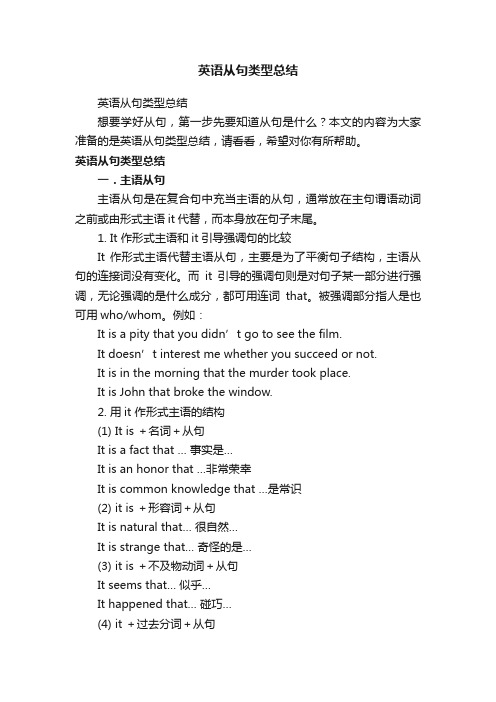
英语从句类型总结英语从句类型总结想要学好从句,第一步先要知道从句是什么?本文的内容为大家准备的是英语从句类型总结,请看看,希望对你有所帮助。
英语从句类型总结一.主语从句主语从句是在复合句中充当主语的从句,通常放在主句谓语动词之前或由形式主语it代替,而本身放在句子末尾。
1. It 作形式主语和it引导强调句的比较It 作形式主语代替主语从句,主要是为了平衡句子结构,主语从句的连接词没有变化。
而it引导的强调句则是对句子某一部分进行强调,无论强调的是什么成分,都可用连词that。
被强调部分指人是也可用who/whom。
例如:It is a pity that you didn’t go to see the film.It doesn’t interest me whether you succeed or not.It is in the morning that the murder took place.It is John that broke the window.2. 用it 作形式主语的结构(1) It is +名词+从句It is a fact that … 事实是…It is an honor that …非常荣幸It is common knowledge that …是常识(2) it is +形容词+从句It is natural that… 很自然…It is strange that… 奇怪的是…(3) it is +不及物动词+从句It seems that… 似乎…It happened that… 碰巧…(4) it +过去分词+从句It is reported that… 据报道…It has been proved that… 已证实…3. 主语从句不可位于句首的五种情况(1) if 引导的主语从句不可居于复合句句首。
(2) It is said , (reported) …结构中的主语从句不可提前。
从句9种全

从句9种全从句是指在复合句中作为独立成分的句子。
根据从句的功能和结构,可以将从句分为多个类型。
本文将介绍完整版从句的九种常见类型,包括:1. 名词性从句:名词性从句可以充当主语、宾语、表语或同位语。
例如:“他说他会来”中的“他会来”是一个宾语从句。
2. 定语从句:定语从句用来修饰名词或代词。
它通常放在被修饰的名词或代词之后。
例如:“我喜欢的书是你给我的那本”中的“你给我的那本”是一个定语从句。
3. 状语从句:状语从句用来修饰动词、形容词或副词,表达时间、地点、原因、条件等信息。
例如:“因为下雨,我没有去游泳”中的“因为下雨”是一个状语从句。
4. 同位语从句:同位语从句用来解释或说明名词的具体内容或性质。
例如:“我听说他被任命为经理”中的“他被任命为经理”是一个同位语从句。
5. 结果从句:结果从句用来表达某个行动或情况的结果。
例如:“她太累,以致于睡着了”中的“以致于睡着了”是一个结果从句。
6. 条件从句:条件从句用来表示某个条件下可能发生的情况。
例如:“如果明天下雨,我们就不去郊游了”中的“如果明天下雨”是一个条件从句。
7. 原因从句:原因从句用来说明某个行动或情况的原因。
例如:“他失败是因为他不努力”中的“因为他不努力”是一个原因从句。
8. 目的从句:目的从句用来表达某个行动或情况的目的。
例如:“我来找你是为了向你道歉”中的“为了向你道歉”是一个目的从句。
9. 让步从句:让步从句用来表示与主句意思相反的情况。
例如:“尽管下雨了,他还是去了”中的“尽管下雨了”是一个让步从句。
以上就是完整版从句的九种类型,希望对您的写作有所帮助。
英语从句的类型总结
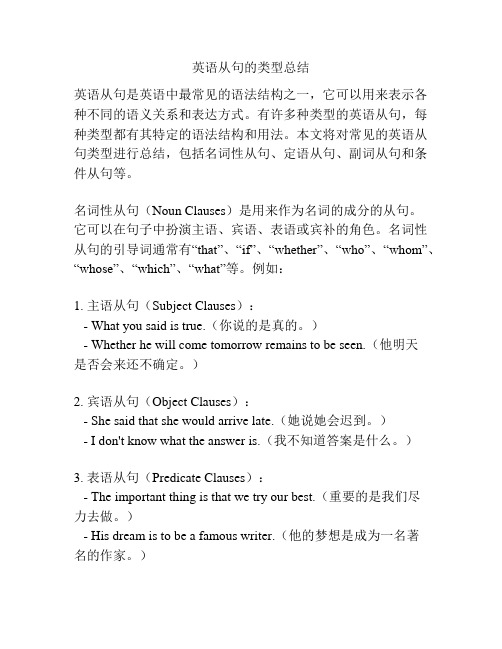
英语从句的类型总结英语从句是英语中最常见的语法结构之一,它可以用来表示各种不同的语义关系和表达方式。
有许多种类型的英语从句,每种类型都有其特定的语法结构和用法。
本文将对常见的英语从句类型进行总结,包括名词性从句、定语从句、副词从句和条件从句等。
名词性从句(Noun Clauses)是用来作为名词的成分的从句。
它可以在句子中扮演主语、宾语、表语或宾补的角色。
名词性从句的引导词通常有“that”、“if”、“whether”、“who”、“whom”、“whose”、“which”、“what”等。
例如:1. 主语从句(Subject Clauses):- What you said is true.(你说的是真的。
)- Whether he will come tomorrow remains to be seen.(他明天是否会来还不确定。
)2. 宾语从句(Object Clauses):- She said that she would arrive late.(她说她会迟到。
)- I don't know what the answer is.(我不知道答案是什么。
)3. 表语从句(Predicate Clauses):- The important thing is that we try our best.(重要的是我们尽力去做。
)- His dream is to be a famous writer.(他的梦想是成为一名著名的作家。
)4. 宾补从句(Complement Clauses):- I made a promise that I would help him.(我承诺会帮助他。
) - They declared him to be the winner.(他们宣布他是胜利者。
)定语从句(Adjective Clauses)是用来修饰名词或代词的从句。
它通常位于被修饰的名词或代词之后,并用来限定或描述该名词或代词。
十大状语从句类型

十大状语从句类型
十大状语从句类型:
1. 时间状语从句
当我们谈到时间时,常常使用时间状语从句来表达具体的时间点或时间段。
例如:当我到达学校时,已经下午三点了。
2. 原因状语从句
我们常常使用原因状语从句来解释一个事件或行为的原因。
例如:我没去参加聚会,是因为我生病了。
3. 条件状语从句
条件状语从句常常用来表达一个条件对结果的影响。
例如:如果明天下雨,我们就不出去玩了。
4. 目的状语从句
目的状语从句用来说明一个行为或动作的目的。
例如:我学习英语,是为了能够和外国人交流。
5. 结果状语从句
结果状语从句用来说明某个行动或情况所导致的结果。
例如:她很努力学习,结果考试取得了好成绩。
6. 让步状语从句
让步状语从句用来表示一个与主句相反的情况或条件。
例如:尽管
下雨了,但他还是出去跑步了。
7. 比较状语从句
比较状语从句用来表示两个或多个事物之间的比较。
例如:他比我更高大。
8. 方式状语从句
方式状语从句用来说明某个行动或动作的方式。
例如:他悄悄地走进房间。
9. 地点状语从句
地点状语从句用来说明某个行动或动作发生的地点。
例如:我们在公园里见面。
10. 比较状语从句
比较状语从句用来表示两个或多个事物之间的比较。
例如:她比我更聪明。
这是十大常见的状语从句类型,通过使用不同类型的状语从句,我们可以更加准确地表达我们的意思,使语言更加丰富多样。
同时,了解这些状语从句的用法也能够帮助我们更好地理解和使用复杂句子。
英语一共有多少个从句类型与用法总结
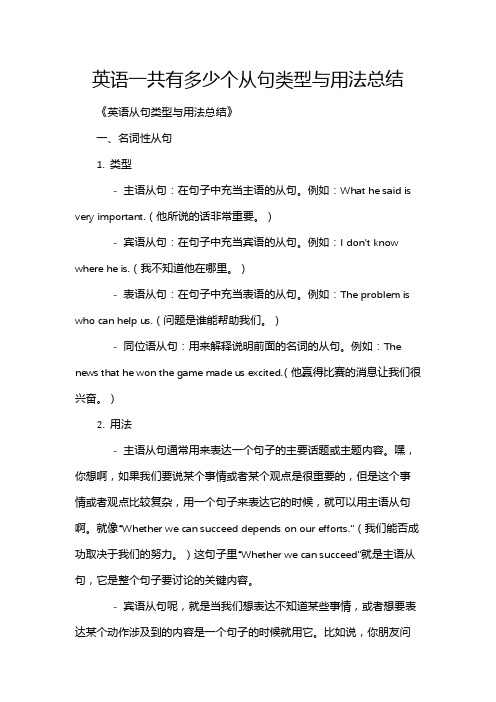
英语一共有多少个从句类型与用法总结《英语从句类型与用法总结》一、名词性从句1. 类型- 主语从句:在句子中充当主语的从句。
例如:What he said is very important.(他所说的话非常重要。
)- 宾语从句:在句子中充当宾语的从句。
例如:I don't know where he is.(我不知道他在哪里。
)- 表语从句:在句子中充当表语的从句。
例如:The problem is who can help us.(问题是谁能帮助我们。
)- 同位语从句:用来解释说明前面的名词的从句。
例如:The news that he won the game made us excited.(他赢得比赛的消息让我们很兴奋。
)2. 用法- 主语从句通常用来表达一个句子的主要话题或主题内容。
嘿,你想啊,如果我们要说某个事情或者某个观点是很重要的,但是这个事情或者观点比较复杂,用一个句子来表达它的时候,就可以用主语从句啊。
就像“Whether we can succeed depends on our efforts.”(我们能否成功取决于我们的努力。
)这句子里“Whether we can succeed”就是主语从句,它是整个句子要讨论的关键内容。
- 宾语从句呢,就是当我们想表达不知道某些事情,或者想要表达某个动作涉及到的内容是一个句子的时候就用它。
比如说,你朋友问你某个地方在哪里,你说“I'm not sure how to get to the library.”(我不确定怎么去图书馆。
)这里的“how to get to the library”就是宾语从句,它是“not sure”这个动作所涉及的内容。
- 表语从句用于系动词后面,用来描述主语的特征或者状态等。
想象一下,主语就像一个人,表语从句就像这个人穿的衣服,用来展示这个人的样子。
比如“He looks as if he were ill.”(他看起来好像生病了。
十大从句类型
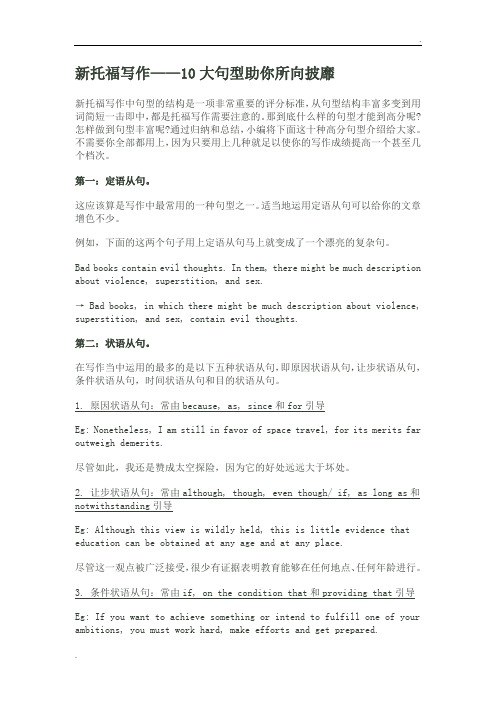
新托福写作——10大句型助你所向披靡新托福写作中句型的结构是一项非常重要的评分标准,从句型结构丰富多变到用词简短一击即中,都是托福写作需要注意的。
那到底什么样的句型才能到高分呢? 怎样做到句型丰富呢?通过归纳和总结,小编将下面这十种高分句型介绍给大家。
不需要你全部都用上,因为只要用上几种就足以使你的写作成绩提高一个甚至几个档次。
第一:定语从句。
这应该算是写作中最常用的一种句型之一。
适当地运用定语从句可以给你的文章增色不少。
例如,下面的这两个句子用上定语从句马上就变成了一个漂亮的复杂句。
Bad books contain evil thoughts. In them, there might be much description about violence, superstition, and sex.→ Bad books, in which there might be much description about violence, superstition, and sex, contain evil thoughts.第二:状语从句。
在写作当中运用的最多的是以下五种状语从句,即原因状语从句,让步状语从句,条件状语从句,时间状语从句和目的状语从句。
1. 原因状语从句:常由because, as, since和for引导Eg: Nonetheless, I am still in favor of space travel, for its merits far outweigh demerits.尽管如此,我还是赞成太空探险,因为它的好处远远大于坏处。
2. 让步状语从句:常由although, though, even though/ if, as long as和notwithstanding引导Eg: Although this view is wildly held, this is little evidence that education can be obtained at any age and at any place.尽管这一观点被广泛接受,很少有证据表明教育能够在任何地点、任何年龄进行。
从句的类型

sick. 3.He was again troubled by the doubt whether or not he might venture to meet Mary at the station. 他再次为是否可冒昧去车站接玛丽这种顾虑所折磨。
1. The rumor spread that Sue and David were having an affair. 关系 暧昧。
2. The suggestion came from the chairman that the new rule be adopted.
Attention: 同位语从句与定语从句的区别: 1)尽管都有先行词,但引导词后面的从句与先行词关系不 同,同位语从句与先行词同位或等同,而定语从句则与先 行词是修饰关系。 2)同位语从句中的that在从句中不充当句子成分。
主语从句
Attention II: 全句是被动结构,常用it 作形式主 语; It is said that he has got married. 全句如是一般疑问句,常用it作形式主语; Is it probable that it will rain today? 全句如是感叹句,常用it 作形式主语; How strange it is that the children are so quiet?
2. She was indifferent to what others were doing.
3. He made a long comment on what they have done.
英语从句类型及判别方法
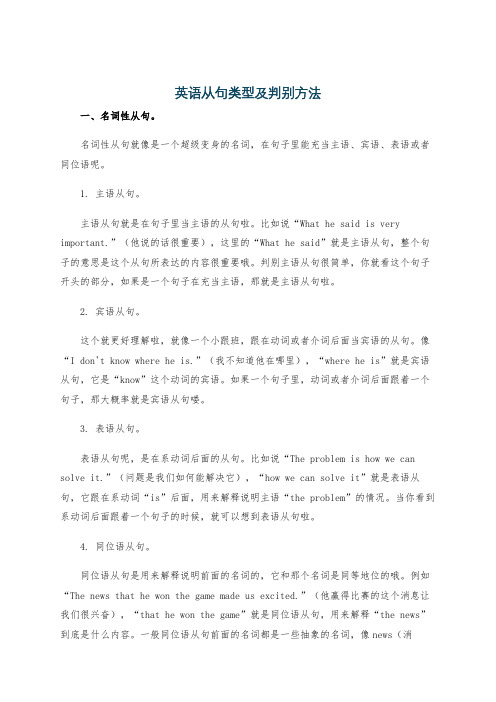
英语从句类型及判别方法一、名词性从句。
名词性从句就像是一个超级变身的名词,在句子里能充当主语、宾语、表语或者同位语呢。
1. 主语从句。
主语从句就是在句子里当主语的从句啦。
比如说“What he said is very important.”(他说的话很重要),这里的“What he said”就是主语从句,整个句子的意思是这个从句所表达的内容很重要哦。
判别主语从句很简单,你就看这个句子开头的部分,如果是一个句子在充当主语,那就是主语从句啦。
2. 宾语从句。
这个就更好理解啦,就像一个小跟班,跟在动词或者介词后面当宾语的从句。
像“I don't know where he is.”(我不知道他在哪里),“where he is”就是宾语从句,它是“know”这个动词的宾语。
如果一个句子里,动词或者介词后面跟着一个句子,那大概率就是宾语从句喽。
3. 表语从句。
表语从句呢,是在系动词后面的从句。
比如说“The problem is how we can solve it.”(问题是我们如何能解决它),“how we can solve it”就是表语从句,它跟在系动词“is”后面,用来解释说明主语“the problem”的情况。
当你看到系动词后面跟着一个句子的时候,就可以想到表语从句啦。
4. 同位语从句。
同位语从句是用来解释说明前面的名词的,它和那个名词是同等地位的哦。
例如“The news that he won the game made us excited.”(他赢得比赛的这个消息让我们很兴奋),“that he won the game”就是同位语从句,用来解释“the news”到底是什么内容。
一般同位语从句前面的名词都是一些抽象的名词,像news(消息)、idea(想法)之类的,后面跟着一个句子来详细解释这个名词,那就是同位语从句啦。
二、形容词性从句(定语从句)定语从句就像是一个小尾巴,用来修饰名词或者代词的。
(完整版)英语所有从句大全
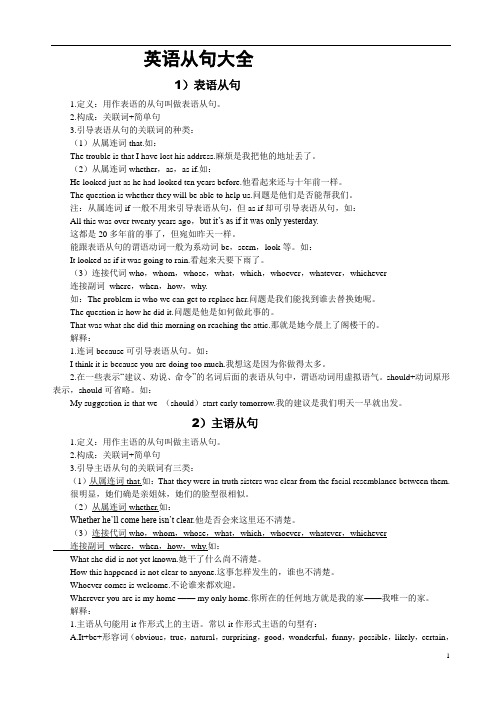
英语从句大全1)表语从句1.定义:用作表语的从句叫做表语从句。
2.构成:关联词+简单句3.引导表语从句的关联词的种类:(1)从属连词that.如:The trouble is that I have lost his address.麻烦是我把他的地址丢了。
(2)从属连词whether,as,as if.如:He looked just as he had looked ten years before.他看起来还与十年前一样。
The question is whether they will be able to help us.问题是他们是否能帮我们。
注:从属连词if一般不用来引导表语从句,但as if却可引导表语从句,如:All this was over twenty years ago,but it’s as if it was only yesterday.这都是20多年前的事了,但宛如昨天一样。
能跟表语从句的谓语动词一般为系动词be,seem,look等。
如:It looked as if it was going to rain.看起来天要下雨了。
(3)连接代词who,whom,whose,what,which,whoever,whatever,whichever连接副词where,when,how,why.如:The problem is who we can get to replace her.问题是我们能找到谁去替换她呢。
The question is how he did it.问题是他是如何做此事的。
That was what she did this morning on reaching the attic.那就是她今晨上了阁楼干的。
解释:1.连词because可引导表语从句。
如:I think it is because you are doing too much.我想这是因为你做得太多。
从句的知识点总结
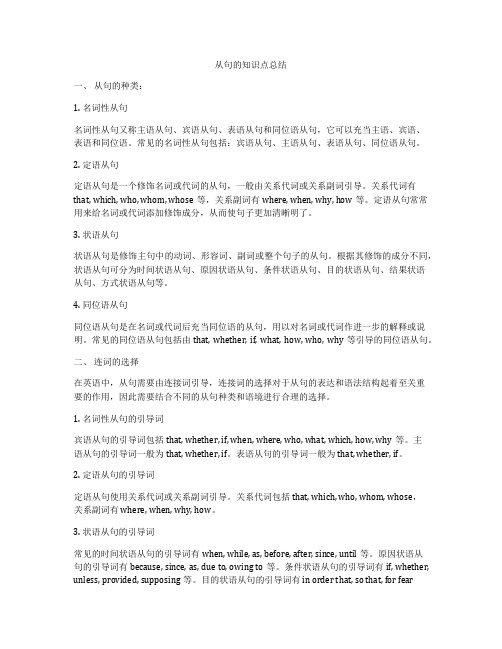
从句的知识点总结一、从句的种类:1. 名词性从句名词性从句又称主语从句、宾语从句、表语从句和同位语从句,它可以充当主语、宾语、表语和同位语。
常见的名词性从句包括:宾语从句、主语从句、表语从句、同位语从句。
2. 定语从句定语从句是一个修饰名词或代词的从句,一般由关系代词或关系副词引导。
关系代词有that, which, who, whom, whose等,关系副词有where, when, why, how等。
定语从句常常用来给名词或代词添加修饰成分,从而使句子更加清晰明了。
3. 状语从句状语从句是修饰主句中的动词、形容词、副词或整个句子的从句。
根据其修饰的成分不同,状语从句可分为时间状语从句、原因状语从句、条件状语从句、目的状语从句、结果状语从句、方式状语从句等。
4. 同位语从句同位语从句是在名词或代词后充当同位语的从句,用以对名词或代词作进一步的解释或说明。
常见的同位语从句包括由that, whether, if, what, how, who, why等引导的同位语从句。
二、连词的选择在英语中,从句需要由连接词引导,连接词的选择对于从句的表达和语法结构起着至关重要的作用,因此需要结合不同的从句种类和语境进行合理的选择。
1. 名词性从句的引导词宾语从句的引导词包括that, whether, if, when, where, who, what, which, how, why等。
主语从句的引导词一般为that, whether, if。
表语从句的引导词一般为that, whether, if。
2. 定语从句的引导词定语从句使用关系代词或关系副词引导。
关系代词包括that, which, who, whom, whose,关系副词有 where, when, why, how。
3. 状语从句的引导词常见的时间状语从句的引导词有when, while, as, before, after, since, until等。
从句的类型及用法总结

从句的类型及用法总结从句是语言中的一种基本成分,它可以扩展句子的信息量,并使句子更加具体和明确。
从句分为几种类型,包括名词性从句、形容词性从句和副词性从句。
本文将对这些从句的类型及其用法进行总结,并举例说明。
一、名词性从句名词性从句可以在句子中充当主语、宾语、表语或宾语补足语。
名词性从句通常由连接词“从属连词”引导,包括“that、whether/if、who、whom、whose、which、what”等。
1. 主语从句主语从句在句子中充当主语,常以“that、whether/if、wh-”为引导词。
例如:- That he has refused to help surprises me. (他拒绝帮助我,让我感到惊讶)- Whether she will come or not is still uncertain. (她是否会来还不确定) - What he said is true. (他说的是真的)2. 宾语从句宾语从句在句子中充当直接宾语或间接宾语,常以“that、whether/if、wh-”为引导词。
例如:- He knows that you are coming. (他知道你要来了)- I wonder if he can finish the task. (我想知道他是否能完成这个任务) - I don't know what he is talking about. (我不知道他在说什么)3. 表语从句表语从句在句子中充当表语,常以“that、whether/if、wh-”为引导词。
例如:- My wish is that you succeed. (我希望你成功)- The fact that he lied shocked everyone. (他撒谎的事实让每个人都感到震惊)4. 宾补从句宾补从句通常跟在某些动词(如“think、believe、find、consider”等)或介词(如“for、on、about”等)后面,充当宾语的补足语,常以“that、whether/if、wh-”为引导词。
从句归纳 区分定语从句、宾语从句、同位语从句
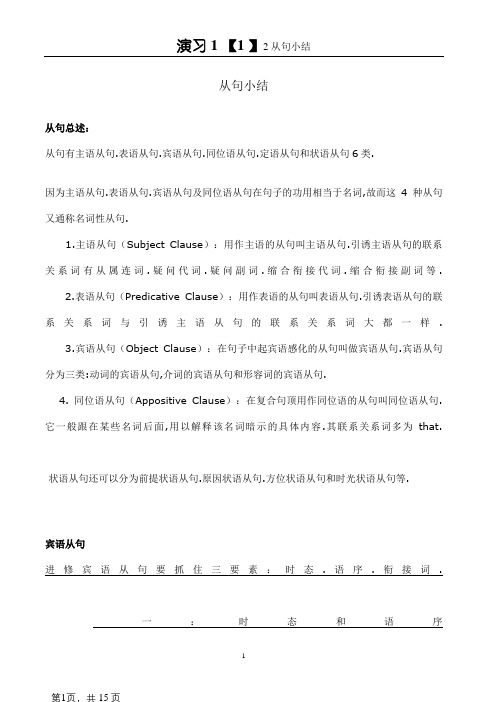
从句小结从句总述:从句有主语从句.表语从句.宾语从句.同位语从句.定语从句和状语从句6类.因为主语从句.表语从句.宾语从句及同位语从句在句子的功用相当于名词,故而这4种从句又通称名词性从句.1.主语从句(Subject Clause):用作主语的从句叫主语从句.引诱主语从句的联系关系词有从属连词.疑问代词.疑问副词.缩合衔接代词.缩合衔接副词等.2.表语从句(Predicative Clause):用作表语的从句叫表语从句.引诱表语从句的联系关系词与引诱主语从句的联系关系词大都一样.3.宾语从句(Object Clause):在句子中起宾语感化的从句叫做宾语从句.宾语从句分为三类:动词的宾语从句,介词的宾语从句和形容词的宾语从句.4. 同位语从句(Appositive Clause):在复合句顶用作同位语的从句叫同位语从句.它一般跟在某些名词后面,用以解释该名词暗示的具体内容.其联系关系词多为that.状语从句还可以分为前提状语从句.原因状语从句.方位状语从句和时光状语从句等.宾语从句进修宾语从句要抓住三要素:时态.语序.衔接词.一:时态和语序1·主句用一般如今时,从句可用随意率性时态.2·主句用曩昔时,从句用曩昔某个时态.3·主句用曩昔时,从句是真谛时,只用一般如今时.语序:宾语从句只能用陈述句语序,果断不克不及用疑问句语序.二:衔接词①从属连词衔接宾语从句的从属连词重要有that,if,whether. that引诱暗示陈述句的宾语从句,而if和whether引诱暗示“是否”的宾语从句.例句:He told that he would go to the college the next year 他告知我他下一年上大学.I don’t know if there will be a bus any more.我不知道是否还会有公交车.②衔接代词衔接代词重要有who, whom ,whose ,what ,whoever ,whomever ,whosever, whatever, whichever等.衔接代词一般指疑问,但what, whatever除了指疑问外,也可以指陈述.例句:Do you know who has won Red Alert game?你知道谁赢了这一局红警游戏吗?③衔接副词衔接副词重要有when,where,why,how,whenever,wherever,however等.例句:He didn’t tell me when we should meet again.他没有告知我什么时刻我们能再会晤.三:动词的宾语从句We all expect that they will win , for members of their team are stronger.我们都预感他们会赢,因为他们的队员更强健.I have found out that all the tickets for the concert have been sold out.我发明这场音乐会的所有票都卖光了.make sure确保make up one’s mind下决心keep in mind切记例句:Make sure that there are no mistakes in your papers before you turn them in.在上交试卷前确保没有任何错误.四:可应用情势宾语it代替的宾语从句①动词find,feel,consider,make,believe等后面有宾语补足语的时刻,则须要用it做情势宾语而将that宾语从句后置.例句:I think it necessary that we take plenty of hot water every day .我以为天天多喝开水是有须要的.I feel it a pity that I haven’t been to the get-together.我没去聚首,感到异常圆满.②有些动词带宾语从句时寻要在宾语与从句前加it这类动词重要有:hate, take , owe, have, see to.例句:I hate it when they with their mouths full of food.我憎恶他们满嘴食物时措辞.五:介词的宾语从句用wh-类的介词宾语从句例句:We are talking about whether we admit students into our club.我们正在评论辩论是否让学生参加我们的俱乐部.I know nothing about my new neighbor except that he used to work witha company.对于我的新邻人我只知道他曾在一家公司上班,其他一窍不通.六:形容词的宾语从句一般来说形容词不克不及带宾语,更不克不及带宾语从句.但以下形容词除外:sure,certain,glad,please,happy,sorry,afraid,satisfied,surprised例句:I am sure I will pass the exam.我确信我会经由过程测验.I am sorry that I have troubled you so long.很抱愧我这么长时光在打搅你.七:if,whether在宾语从句中的差别①if和whether在作“是否”解时,引诱宾语从句常放在动词know,ask,care,wonder,find out等之后,介词后一般不必if②少数动词,如:leave,put,discuss,doubt后的宾语从句经常应用whether.③whether后可以加or not,但是if不成以.④在不定式前只能用whether.如:I can’t decide whether to stay. 我不克不及决议是否留下.⑤防止歧异时,我们经常应用whether而不必if.八:哪些宾语从句不成以省略引诱词that①当一个动词带有两个或两个以上宾语从句时,此时第一个that可以省略,第二个that 不成以省略;②当宾语从句有it做其先行词时;九:宾语从句的否认转移主句的谓语动词是think,believe,imagine,suppose,consider,espect,fancy,guess等,并且主句的主语是第一人称并且为一般如今时,从句的否认词一般要转移到主句上来,其反义疑问句一般与宾语从句一致.例句:I don’t think he will come to my party.而不克不及说成I think he won’t come to my party.我以为他不会来我的舞会.I don’t believe that man is killed by Jim,is he?我以为那小我不是Jim所杀的,是不是?★假如宾语从句中有某个含有否认意义的形容词或副词,其反义疑问句要用确定情势.例句:We find that he never listens to the teacher carefully,does he?我们发明他从来不仔谛听师长教师授课,是不是?十:宾语从句的时态和语序当主句为如今时或未来时的时刻,宾语从句的时态一般不受主句的时态所影响.当主句为曩昔时的时刻,从句只能用和曩昔相干的时态.例句:The reporter asked if the government would take necessary measures to put down the to-do.记者问当局是否会采纳须要的措施镇压动乱.★假如从句是一个客不雅真谛,那么从句的时刻不依据主句的时态而变更例句:The teacher said that the moon goes around the earth yesterday.师长教师昨天说月亮绕着地球转.★宾语从句的拔出语情势例句:Who do you think the public might choose as their favorite singer this year?你以为本年大众会选谁为他们最爱好的歌手.同位语从句(Appositive Clause):在复合句顶用作同位语的从句叫同位语从句.它一般跟在某些名词后面,用以解释该名词暗示的具体内容.其联系关系词多为that.一.如:I heard the news that our team had won.我听到了我们队获胜的新闻.I had no idea that you were here.我不知道你在这里.二.可以跟同位语从句的名词平日有news,idea,fact,promise,question,doubt,thought,hope,message,suggestion,wor ds(新闻),possibility等,可睁开来的抽象名词.如:I’ve come from Mr wang with a message that he won’t be able to see you this afternoon.我从王师长教师那边来,他让我告知你他今世界午不克不及来看你了.三.英语中引诱同位语从句的词通有连词that,whether,衔接副词how,when,where 等.依据句意决议该用哪一个.l have no idea When he will be back.我不知道他什么时刻回来.定语从句(Attributive Clause):用作定语的从句叫定语从句.定语从句一般皆放在被它所润饰的名(代)词之后,这种名(代)词就叫作先行词(Antecedent).引诱定语从句的联系关系词为关系代词和关系副词.关系代词在定语从句中可用作主语.宾语.定语等;关系副词在定语从句顶用作状语.①引诱定语从句的联系关系词有who, whom, whose, that, when, where, why 和 which. 在非限制订语从句中, 只可用which, who, whose, where , when., 假如指代前面全部句子, 多用which.例句:The dog that/which was lost has been found.(掉踪的狗已经找到了.)Those who are in favor of the proposal are expected to discuss it in detail after the meeting.(有人以为那些对这个提案有兴致的人最好是在会后再具体评论辩论它.)There are many organizations whose purpose is to help the homeless.(消失着很多旨在帮忙无家可归者的组织.)②当引诱定语从句的先行词前有all, any, no, little, much, very first 等词, 或先行词前为形容词最高等所润饰时,或先行词为all, anything, nothing, something, everything 时,从句的引诱词只能用that.The only thing that matters to the children is how soon they can have their holiday.(孩子们独一关怀的是他们什么时刻放假.)These are the very points that puzzle me.(真正困扰我的是这些不雅点.)Is there anything that bothers you?(有什么事烦着你吗?)This is the best film that was ever produced by the company.(这部是谁人公司有史以来拍摄得最好的片子.)③as 可做引诱词引诱定语从句, 多和such, the same 连用. 或者用在“从句比主句先产生”的情形,有“像……一样”之意.As 引诱的定语从句也可润饰全部句子, 既可放在先行词后,也可放在句子开首.例句:Such people as you describe are rare nowadays.(你描写的那一类人如今很少了.)The boy was run over by a motor-car, as often happened in pre-liberation Shanghai.(谁人男孩被一辆摩托轧曩昔了,这种事在解放前的上海是很多见的.)As is often the case, the girl forgot to bring her dictionary.(正如往常一样,这个女孩又忘了带上字典.)④介词+which/whom/whose从句The driver is the man from whose room she had stolen the gold watch.(她就是从谁人司机的房间偷了金表的.)Language is a tool by means of which people communicate ideas with each other.(说话就是人们用来和其他人交换的一种对象.)例题:Water dissolves a part of nearly everything _______ it comes in contact.a. whereb. that c with which d as soon as⑤代/名+介词+which 从句He is needing a book, the name of which I don't know.(他须要一本书,但是我不知道书名.)In factories and in our daily life, there are many waste materials, all of which can he turned into useful things under certain condition.(在工场里,在我们的日常生涯中都有很多垃圾,其实这些垃圾在某种情形下是可以改变成有效的器械的.)同位语从句与定语从句的差别.1.同位语从句与前面的名词是同位关系,即解释它前面名词的内容;而定语从句与前面的名词是润饰与被润饰关系,即限制它前面的名词规模,或填补一些情形.如:The news that l have passed the exam is true.我经由过程了测验这一新闻是真的.(同位语从句,即从句所表达的意思就是前面名词的内容.)The news that he told me just now is true.他适才告知我的新闻是真的.(定语从句,从句对前面名词起润饰限制造用,即“他告知我的”谁人新闻,而不是此外新闻.)2.引诱同位语从句的that是连词,在从句中不充当任何成份,而引诱定语从句的that 是关系代词,除起衔接感化外,还在从句中充当主语.宾语或表语等.如:The idea that computers can recognize human voices surprises many people.盘算机可以或许识他人的声音的设法主意使很多人觉得惊异.(that在从句中不充当任何成份.)The idea that he gave surprises many people.他提出的不雅点令很多人觉得吃惊.(that在从句中作gave的宾语.)状语从句(Adverbial Clause):用作状语的从句叫作状语从句.其联系关系词是一些从属连词.润饰主句中的动词, 形容词和副词, 平日有从属连词引诱, 按其意义和感化可分为时光, 地点, 前提, 原因, 妥协, 目标, 成果, 方法, 比较.等分类1. 时光状语从句:1) 罕有连词有after,as,before,once,since,till,(not)until,when,whenever (no matter when),while, as long as…2) no sooner…than, hardly(scarcely, barely)…when: 刚做…就….No sooner had I opened the door than the telephone rang.3) 还有immediately, directly, instantly, the moment, the minute, theinstant, the second, every time etc I’ll tell you about it the moment you come.I got in touch with him immediately I received his letter.2. 地点状语从句: 一般用where or wherever 引诱I will stand where I can see the parade clearly.Wherever they went, they were warmly welcome.3. 前提状语从句:真实前提从句:if, unless, so long as, provided that, supposing that, on condition that, in the event that, in case that etcI will not go to her party if she doesn’t invite me.I will not go to her party unless she invites me.4. 原因状语从句: 从属连词有because, as ,since, for, now, that, in that, seeing that, considering that(鉴于,因为) As the school regulations are written quite clearly, there is nothing more to be explained.Considering that the sweater was hard made, it was not expensive.Seeing that they are inexperienced, they are doing quite a good job.5. 妥协状语从句:1): even if, though, even though, while(尽管) no matter what/how/which, however, whatever, whichever, however etc.He will not give up smoking even though the doctor advises him to.Whatever the consequence may be, I will be on your side.However hard she tried to explain, nobody trusted her.It has been the same result, whichever way you do it.112) 由as 引起的妥协从句, 语气较强烈,被强调的词须放在句首.Simple as the question may seem, it is not at all common in nature.Cold as it is, the children play outdoors.Much as I respect him, I can’t agree with him.Object as you may, I will go on with my plan.3) whether…or,不管…或…whether you be a student or a teacher, you are required to obey the regulations of the school.6. 成果状语从句: so that, so…that, such…thatHe is so humorous that we’ll never forget him.She is such a nice girl that everybody likes to make friends with her.7. 目标状语从句: so that, in order that, for fear that, lest, in caseI checked all the results time and again for fear that there should be any mistakes.Telephone us in advance in order that we might make the necessary arragements.8.方法状语从句方法状语从句平日由as, (just) as…so…, as if, as though引诱.1)as, (just) as…so…引诱的方法状语从句平日位于主句后,但在(just) as…so…构造中位于句首,这时as从句带有比方的寄义,意思是"正如…","就像",多用于正式体裁,例如:Always do to the others as you would be done by.你愿望人家如何待你,你就要如何待人.12As water is to fish, so air is to man.我们离不开空气,如同鱼儿离不开水.Just as we sweep our rooms, so we should sweep backward ideas from our minds.正如打扫衡宇一样,我们也要清除我们脑筋中落伍的器械.2)as if, as though 两者的意义和用法雷同,引出的状语从句谓语多用虚拟语气,暗示与事实相反,有时也用陈述语气,暗示所讨情形是事实或实现的可能性较大.汉译常作"仿佛……似的","似乎……似的",例如:They completely ignore these facts as if (as though) they never existed.他们完整疏忽了这些事实,就仿佛它不消失似的.(与事实相反,谓语用虚拟语气.)He looks as if (as though) he had been hit by lighting.他那样子就像被雷击了似的.(与事实相反,谓语用虚拟语气.)It looks as if the weather may pick up very soon.看来气象很快就会好起来.(实现的可能性较大,谓语用陈述语气.)解释:as if / as though也可以引诱一个分词短语.不定式短语或无动词短语,例如:He stared at me as if seeing me for first time.他目不转睛地看着我,就像第一次看见我似的.He cleared his throat as if to say something.他清了清嗓子,像要说什么似的.The waves dashed on the rocks as if in anger.波澜冲击着岩石,似乎很恼怒.9. 比较状语从句:131) as…as, not so/as…as the film was not so exciting as we expected.这部片子没有我们等待的一样出色The history of nursing is as old as the history of man.She likes them almost as much as Paul does.2) 比较级+than, so much/a lot more thanShe looks much younger than she is.The universe is a lot more complicated than you think.3) no more…than, not more…than, less…than Jack is not more frightened than Mike is. 不像马克那么畏惧Tom is no more rich than Black3) the more…the moreThe farther north you go, the severer the winter is.The more I see of him, the less I like him.14。
9大从句类型 记忆

9大从句类型记忆从句是英语语法中一个重要的部分,它们使得句子更加丰富和复杂。
一、时间状语从句常用引导词:when(在…时),as(当…时),while(在…期间),as soon as(一……就……),before (在…之前),after(在...之后),since(自从...以来),not...until(直到…才)until/till(直到…时)等特殊引导词:the minute,the moment,the second,every time,the day,the instant(瞬间,顷刻),immediately,directly(不久,立即),no sooner…than(一...就...),hardly…when(刚一...就...),scarcely…when(刚...就.../一...就...),as soon as(一…就…)。
时间状语从句的引导词所表示的意思不尽相同,要注意把握不同引导词所表示的不同时间关系,以及它在具体句子中对应的时态、语态等问题。
注意:as(在……时候,因为),since(自从,因为),它们可以引导时间从句,并强调主句和从句的动作同事发生。
并且while有时还可以表示对比。
例如:(1)While my mother was reading the newspaper,I was watching TV.(read是延续性的动词,read和watch同事发生)I like playing football while you like playing basketball.我喜欢踢足球,而你喜欢打篮球。
(对比)(2)when(当……的时候),引导的从句的谓语动词可以是延续性动词,也可以是瞬间动词。
从句动作可与主语动作同事发生,也可在其后发生。
I was reading a book when she came into my room.(come是瞬间动词,只能用when引导,不能用while)I often missed my home when(while)I lived in NewYork.(live是延续性动词,when可用while代替)(3)when和while的区别还在于:while引导的时间状语从句多用于进行时态,而when引导的时间状语从句多用于一般时态。
从句类型及例子

从句类型及例子一、名词性从句名词性从句是在句子中充当名词的从句,可以作主语、宾语、表语或同位语。
常见的名词性从句有主语从句、宾语从句、表语从句和同位语从句。
1. 主语从句主语从句充当主句的主语,常用引导词有that、whether等。
例如:“你知道是否会下雨吗?”这个句子中,是否会下雨是主语从句,引导词是whether。
2. 宾语从句宾语从句充当主句的宾语,常用引导词有that、whether、if等。
例如:“我不知道他是否会来。
”这个句子中,他是否会来是宾语从句,引导词是whether。
3. 表语从句表语从句充当主句的表语,常用引导词有that、whether等。
例如:“我不确定他是否是个好人。
”这个句子中,他是否是个好人是表语从句,引导词是whether。
4. 同位语从句同位语从句充当主句中某个名词的同位语,常用引导词有that、whether等。
例如:“我听说他得了一种叫做流感的疾病。
”这个句子中,他得了一种叫做流感的疾病是同位语从句,引导词是that。
二、形容词性从句形容词性从句是在句子中充当形容词的从句,修饰一个名词或代词。
常用引导词有that、which、who、whom、whose、when、where、why等。
5. 限制性形容词性从句限制性形容词性从句对先行词起限制或修饰作用,不可省略。
例如:“我喜欢那个穿红衣服的女孩。
”这个句子中,穿红衣服的是形容词性从句,修饰女孩。
6. 非限制性形容词性从句非限制性形容词性从句对先行词起补充说明或解释作用,用逗号与主句隔开。
例如:“我的朋友,他是一名医生,今天来看望我。
”这个句子中,他是一名医生是形容词性从句,补充说明朋友的身份。
三、副词性从句副词性从句是在句子中充当副词的从句,修饰动词、形容词或副词。
常用引导词有when、where、why、how、as、since、until、unless等。
7. 时间副词从句时间副词从句表示动作发生的时间,常用引导词有when、while、as、since、before、after、until等。
英语从句(最简单通俗易懂)
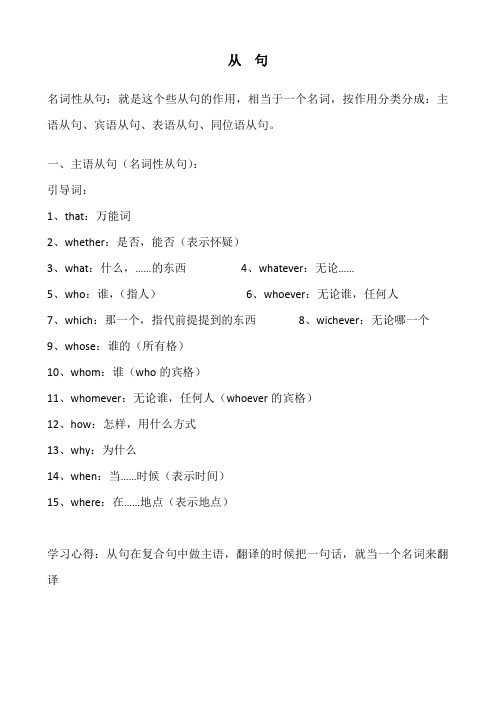
从句名词性从句:就是这个些从句的作用,相当于一个名词,按作用分类分成:主语从句、宾语从句、表语从句、同位语从句。
一、主语从句(名词性从句):引导词:1、that:万能词2、whether:是否,能否(表示怀疑)3、what:什么,……的东西4、whatever:无论……5、who:谁,(指人)6、whoever:无论谁,任何人7、which:那一个,指代前提提到的东西8、wichever:无论哪一个9、whose:谁的(所有格)10、whom:谁(who的宾格)11、whomever:无论谁,任何人(whoever的宾格)12、how:怎样,用什么方式13、why:为什么14、when:当……时候(表示时间)15、where:在……地点(表示地点)学习心得:从句在复合句中做主语,翻译的时候把一句话,就当一个名词来翻译二、宾语从句(名词性从句):引导词:1、that:万能词(无意思,只是符号,有的时候会省略)2、who:谁,(指人)3、why:为什么4、when:当……时候(表示时间)5、which:那一个,指代前提提到的东西6、what:什么,……的东西7、how:怎样,用什么方式8、whether:是否,能否(表示怀疑)9、if:如果(表示假设)注:放在非谓语动词(动名词)后面的句子也叫做宾语从句。
如:knowing that………………………………三、表语从句(名词性从句):引导词:1、that:万能词2、whether:是否,能否(表示怀疑)3、what:什么,……的东西4、whatever:无论……5、who:谁,(指人)6、whoever:无论谁,任何人7、which:那一个,指代前提提到的东西8、wichever:无论哪一个9、whose:谁的(所有格)10、whom:谁(who的宾格)11、whomever:无论谁,任何人(whoever的宾格)12、how:怎样,(表示方式)13、why:为什么(表示原因)14、when:当……时候(表示时间)15、where:在……地点(表示地点)16、as if:好像,似乎(表示可能)17、as though:好像,仿佛(表示可能)学习心得:用句子表示名词,在句中做表语,引导词跟主语从句一样。
英语六大句式及十大从句类型

一、句型1: Subject (主语) + Verb (谓语)之阳早格格创做那种句型中的动词汇大多是不迭物动词汇,罕睹的动词汇如: work, sing, swim, fish, jump, arrive, come, die, disappear, cry, happen等.如:1) Li Ming works very hard.李明教习很齐力.2) The little girl cried even harder. 小女孩哭得更锋利了.3) The accident happened yesterday afternoon.事变是今天下午爆收的.二、句型2:Subject (主语) + Link. V(系动词汇) +Predicate(表语)那种句型主要用去表示主语的特性、身份等.其系动词汇普遍可分为下列二类:(1)表示状态.那样的词汇有:be, look, seem, smell, taste, sound, keep等.如:1) This kind of food tastes delicious.那种食物吃起去很美味.2) He looked worried just now.刚刚才他瞅上去有些焦慢.(2)表示变更.那类系动词汇有:become, turn, get, grow, go等.如:1) Spring comes. It is getting warmer and warmer. 秋天到了,天气变得越去越温战.2) The tree has grown much taller than before. 那棵树比往日少得下多了.三、句型3:Subject(主语) + Verb (谓语) + Object (宾语)那种句型中的动词汇普遍为及物动词汇.其宾语常常由名词汇、代词汇、动词汇大概式、动名词汇大概从句等去充当.1) He took his bag and left.(名词汇)他拿着书籍包离启了.2) Li Lei always helps me when I have difficulties. (代词汇) 当尔逢到艰易时,李雷总能给尔帮闲.3) She plans to travel in the coming May Day.(大概式)她挨算正在将要到去的“五一”出门旅游.4) I don’t know what I should do n ext. (从句)尔不了解下一步该搞什么.四、句型4: Subject(主语)+Verb(谓语)+ Indirect object(间交宾语)+Direct object (曲交宾语)那种句型中,曲交宾语为主要宾语,正在句中不可大概缺,时常由表示“物”的名词汇去充当;间交宾语也被称之为第二宾语,去掉之后,对付所有句子的效率不大,多由指“人”的名词汇大概代词汇背担.带收那类单宾语的罕睹动词汇有:buy, pass, lend, give, tell, teach, show, bring, send等.1) Her father bought her a dictionary as a birthday present. 她爸爸给她购了一本词汇典动做死日礼物.2)The old man always tells the children stories about the heroes in the Long March. 老人时常给孩子们道述少征途中那些英雄的故事.1)Her father bought a dictionary for her as a birthday present.2)The old man always tells stories about the heroes to the children in the Long March.五、句型5: Subject(主语)+Verb (动词汇)+Object (宾语)+Complement(补语) 那种句型中的“宾语+补语”统称为“复合宾语”.宾语补脚语的主要效率大概者是补充、证明宾语的特性、身份等;大概者表示让宾语去完毕的动做等.担当补语的时常是名词汇、形容词汇、副词汇、介词汇短语、分词汇、动词汇大概式等.1)You should keep the room clean and tidy. 您该当让屋子脆持搞净整净.(形容词汇)2) We made him our monitor.(名词汇)咱们选他当班少.3) His father told him not to play in the street.(大概式)他女亲报告他不要正在街上玩.● 罕睹的动词汇有: tell, ask, advise, help, want, would like, order, force, allow等.● 注意:动词汇have, make, let, see, hear, notice, feel, watch等后里所交的动词汇大概式做宾补时,不戴to.1) The boss made him do the work all day.老板让他整天搞那项处事.2) I heard her sing in the next room all the time last night. 今天早上尔听睹她正在隔壁唱了一个早上.句型六:There be + 主语 + 其余那一结构表示“某天有某物”.主语普遍位于there be 之后.值得闭注的是,当句中有二个大概更多的主语时,动词汇普遍战迩去的一个脆持普遍:1) There are two girls and a boy running on the playground第一:定语从句.定语从句正在句子中做定语,用去建饰一个名词汇、名词汇词汇组大概者代词汇.先止词汇战带收词汇被建饰的名词汇、名词汇词汇组大概代词汇喊搞先止词汇;正在先止词汇战定语从句之间起连交效率的词汇喊搞带收词汇.带收词汇分为“闭系代词汇”战“闭系副词汇”.闭系代词汇有:who, whom, whose, that, which, as. 闭系副词汇有:when, where, why.比圆,底下的那二个句子用上定语从句赶快便形成了一个漂明的搀纯句.Bad books contain evil thoughts. In them, there might be much description about violence, superstition, and sex.→ Bad books, in which there might be much description ab out violence, superstition, and sex, contain evil thoughts.第二:状语从句.正在句子中起状语效率的从句喊搞状语从句.状语从句由从属连词汇带收. 状语(adverbial)是句子的要害建饰身分.状语是谓语里的另一个附加身分,它附加正在谓语核心语的前里,从情况、时间、处所、办法、条件、对付象、肯定、可定、范畴战程度等.正在写做核心使用的最多的是以下五种状语从句,即本果状语从句,让步状语从句,条件状语从句,时间状语从句战脚段状语从句.1. 本果状语从句:常由because, as, since战for带收Eg: Nonetheless, I am still in favor of space travel, for its merits far outweigh demerits.纵然如许,尔仍旧赞成太空探险,果为它的佳处近近大于弊端.2. 让步状语从句:常由although, though, even though/ if, as long as战notwithstanding带收Eg: Although this view is wildly held, this is little evidence that education can be obtained at any age and at any place.纵然那一瞅面被广大交受,很罕见凭证标明培养不妨正在所有天面、所有年龄举止.3. 条件状语从句:常由if, on the condition that战providing that带收Eg: If you want to achieve something or intend to fulfill one of your ambitions, you must work hard, make efforts and get prepared.假若您要博得成便大概要真止您的雄心壮志,您必须齐力处事、费力搏斗、准备佳条件.4. 时间状语从句:常由when战while带收Eg: When it comes to education, the majority of people believe that education is a lifetime study.道到培养,大部分人认为其是一个终死的教习.5. 脚段状语从句: 常由so that战in order that带收Eg: Millions of people have to spend more time and energy on studying new skills and technology so that they can keep a favorable position in job market.成千上万的人们不克不迭不耗费的粗力战时间教习新的技能战知识,使得他们正在便业商场能脆持劣势.第三:宾语从句.正在句子中起宾语效率的从句喊搞宾语从句.宾语从句的带收词汇战主语从句的带收词汇相共.宾语从句不妨做及物动词汇的宾语,做短语动词汇的宾语,介词汇的宾语.Eg: Some people claim that government should be mainly responsible for the environmental pollution.一些人认为政府应付于环境传染背主要责任.Eg: Many experts point out that, along with the development of modern society, it is an inevitable result and there is no way to avoid it.许多博家指出那是新颖社会死少必定的截止,无法预防.第四:共位语从句.正在复合句主句中名词汇性身分之后与该名词汇性身分并列,补充证明该名词汇性身分的有闭情况的名词汇性从句,被称为共位语从句.Eg: It is an undeniable fact that environmental pollution becomes increasingly serious.环境传染变得越去越宽沉是不可启认的究竟.Eg: No one can deny the basic fact that it is impossible for average workers to master those high-technology skills easily.不人是启认那一基础收真:对付于普遍工人去道,沉快掌握那些技能是不可能的.第五:主语从句.一what, who, whom, whose, which, whatever,whoever, whiche ver等连交代词汇带收的主语从句以that, whether从属连词汇带收的主语从句以 when, where, how, why等连交副词汇带收的主语从句第六:强调句: It is + 被强调的真质 + thatEg: It is cars and factories that release a great deal of gases, polluting the environment.汽车战工厂排搁洪量的兴气,使得环境被传染.第七:倒拆句.Eg: Only if the government will take some appropriate measures, will this intractable problem be tackled.惟有政府采与适合的步伐,那个棘脚的问题才搞被办理.第八:主动语态.Eg: Every means should be tried to protect the environment on which people live.人们应竭尽鼎力去呵护咱们好以存正在的环境.第九:分词汇结构:包罗当前分词汇战往日分词汇.Eg: Tourism, which is a rising industry, has become the major source of economy, playing crucial role in many Asian countries.旅游业是一个新兴的止业,它成为经济的主要, 正在很多东北亚国家起着尤为要害的效率.Eg: To be more specific, government should stage some relevant laws or regulations to severely punish the factory producing a great number of pollutants and the people littering or spitting deliberately.简曲去道,政府该当出台相闭执法规则对付制制洪量传染物的工厂及蓄意治扔垃圾随天吐痰的人举止宽奖.第十:拔出语.一种独力身分,与句子的其余身分普遍不语法上的闭系,多数是对付一句话做一些附加证明大概阐明.它常常由一个词汇、一个短语大概一个句子形成,位子较为机动,可置于句尾、句中大概句终,普遍用逗号大概破合号与句子隔启.Eg: Computer, an indispensable part in our life, has brought us great conveniences.电脑,咱们死计中必不可少的一部分,给咱们戴去了极大的便当.Eg: College students, lacking social experience, are easily cheated.大教死,不社会体味,简单上当受骗.以上便是新托祸写做帮您所背披靡的一些句型,写做本去不可怕,只消您多多训练,流利掌握那些句型并机动使用到写做中去,念要正在俗思大概托祸写做部分得到一个比较谦意的分数将不再是一个遥不可及的幻念.大家当前便止径起去吧!。
从句的类型及引导词总结
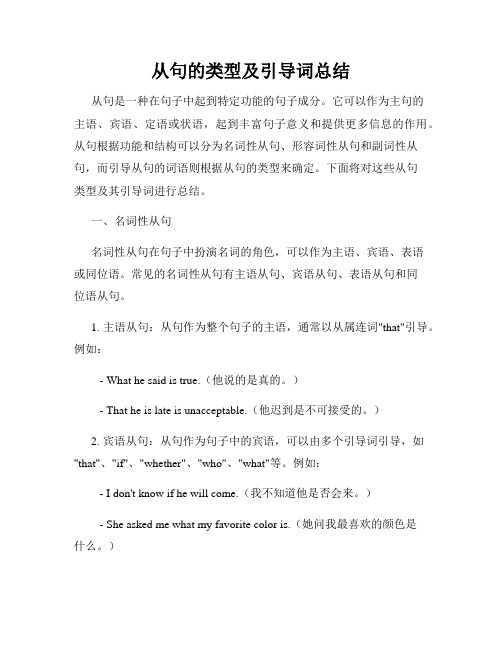
从句的类型及引导词总结从句是一种在句子中起到特定功能的句子成分。
它可以作为主句的主语、宾语、定语或状语,起到丰富句子意义和提供更多信息的作用。
从句根据功能和结构可以分为名词性从句、形容词性从句和副词性从句,而引导从句的词语则根据从句的类型来确定。
下面将对这些从句类型及其引导词进行总结。
一、名词性从句名词性从句在句子中扮演名词的角色,可以作为主语、宾语、表语或同位语。
常见的名词性从句有主语从句、宾语从句、表语从句和同位语从句。
1. 主语从句:从句作为整个句子的主语,通常以从属连词"that"引导。
例如:- What he said is true.(他说的是真的。
)- That he is late is unacceptable.(他迟到是不可接受的。
)2. 宾语从句:从句作为句子中的宾语,可以由多个引导词引导,如"that"、"if"、"whether"、"who"、"what"等。
例如:- I don't know if he will come.(我不知道他是否会来。
)- She asked me what my favorite color is.(她问我最喜欢的颜色是什么。
)3. 表语从句:从句作为句子中的表语,通常以从属连词"that"引导。
例如:- The fact is that he lied to us.(事实是他对我们撒了谎。
)- My dream is that I can travel around the world.(我的梦想是能环游世界。
)4. 同位语从句:从句作为另一个名词或代词的同位语,通常以从属连词"that"或连接代词/连接副词引导。
例如:- The news that she won the first prize was exciting.(她赢得一等奖的消息令人激动。
宾语从句的类型
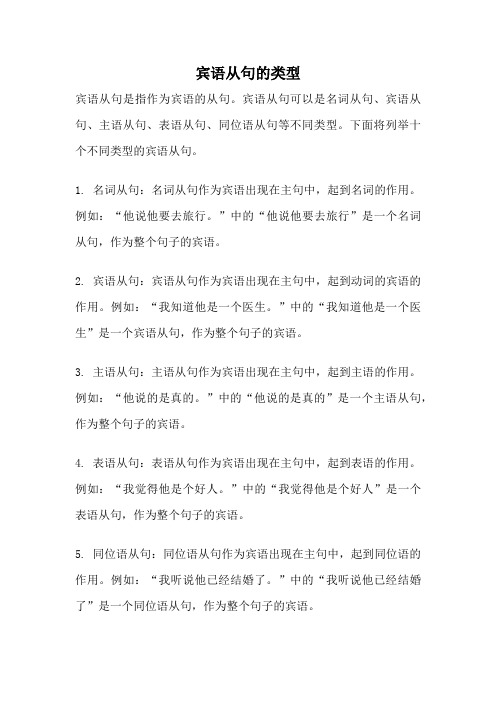
宾语从句的类型宾语从句是指作为宾语的从句。
宾语从句可以是名词从句、宾语从句、主语从句、表语从句、同位语从句等不同类型。
下面将列举十个不同类型的宾语从句。
1. 名词从句:名词从句作为宾语出现在主句中,起到名词的作用。
例如:“他说他要去旅行。
”中的“他说他要去旅行”是一个名词从句,作为整个句子的宾语。
2. 宾语从句:宾语从句作为宾语出现在主句中,起到动词的宾语的作用。
例如:“我知道他是一个医生。
”中的“我知道他是一个医生”是一个宾语从句,作为整个句子的宾语。
3. 主语从句:主语从句作为宾语出现在主句中,起到主语的作用。
例如:“他说的是真的。
”中的“他说的是真的”是一个主语从句,作为整个句子的宾语。
4. 表语从句:表语从句作为宾语出现在主句中,起到表语的作用。
例如:“我觉得他是个好人。
”中的“我觉得他是个好人”是一个表语从句,作为整个句子的宾语。
5. 同位语从句:同位语从句作为宾语出现在主句中,起到同位语的作用。
例如:“我听说他已经结婚了。
”中的“我听说他已经结婚了”是一个同位语从句,作为整个句子的宾语。
6. 疑问词+动词+宾语从句:疑问词引导的宾语从句作为宾语出现在主句中,起到回答疑问的作用。
例如:“我不知道他什么时候回来。
”中的“我不知道他什么时候回来”是一个疑问词引导的宾语从句,作为整个句子的宾语。
7. that引导的宾语从句:that引导的宾语从句作为宾语出现在主句中,起到引导从句的作用。
例如:“我相信他会成功。
”中的“我相信他会成功”是一个that引导的宾语从句,作为整个句子的宾语。
8. whether或if引导的宾语从句:whether或if引导的宾语从句作为宾语出现在主句中,起到引导从句的作用。
例如:“我不知道他是否会来。
”中的“我不知道他是否会来”是一个whether或if 引导的宾语从句,作为整个句子的宾语。
9. 介词+宾语从句:介词引导的宾语从句作为宾语出现在主句中,起到介词宾语的作用。
- 1、下载文档前请自行甄别文档内容的完整性,平台不提供额外的编辑、内容补充、找答案等附加服务。
- 2、"仅部分预览"的文档,不可在线预览部分如存在完整性等问题,可反馈申请退款(可完整预览的文档不适用该条件!)。
- 3、如文档侵犯您的权益,请联系客服反馈,我们会尽快为您处理(人工客服工作时间:9:00-18:30)。
新托福写作——10大句型助您所向披靡
新托福写作中句型得结构就就是一项非常重要得评分标准,从句型结构丰富多变到用词简短一击即中,都就就是托福写作需要注意得。
那到底什么样得句型才能到高分呢?怎样做到句型丰富呢?通过归纳与总结,小编将下面这十种高分句型介绍给大家。
不需要您全部都用上,因为只要用上几种就足以使您得写作成绩提高一个甚至几个档次。
第一:定语从句。
这应该算就就是写作中最常用得一种句型之一。
适当地运用定语从句可以给您得文章增色不少。
例如,下面得这两个句子用上定语从句马上就变成了一个漂亮得复杂句。
Bad books containevilthoughts、In them, there migh t be much description aboutviolence, superstition, and sex、
→ Bad books,in which there might be much description abo ut violence, superstition, andsex,containevil t houghts、
第二:状语从句。
在写作当中运用得最多得就就是以下五种状语从句,即原因状语从句,让步状语从句,条件状语从句,时间状语从句与目得状语从句。
1、原因状语从句:常由because, as, since与for引导
Eg: Nonetheless, I am still in favor ofspace travel, for its merits far outweigh demerits、
尽管如此,我还就就是赞成太空探险,因为它得好处远远大于坏处。
2、让步状语从句:常由although, though, even though/ if, as long as与notwithstanding引导
Eg: Although this view is wildly held, this is little evi dence that educationcan be obtained at any age and at any place、
尽管这一观点被广泛接受,很少有证据表明教育能够在任何地点、任何年龄进行。
3、条件状语从句:常由if, on the condition that与providing th at引导
Eg: If you want to achieve something or intendto fulfill one of your ambitions, you must work hard, make efforts an dget prepared、
假如您要取得成就或要实现您得雄心壮志,您必须努力工作、艰苦奋斗、准备好条件。
4、时间状语从句:常由when与while引导
Eg: When it estoeducation, the majority ofpeople bel ievethateducationis a lifetime study、
说到教育,大部分人认为其就就是一个终生得学习。
5、目得状语从句: 常由sothat与in order that引导
Eg: Millions of peoplehave to spend more timeandenergy on studying new skills and technology sothatthey can keep a favorable position in job market、
成千上万得人们不得不花费得精力与时间学习新得技术与知识,使得她们在就业市场能保持优势。
第三:宾语从句。
Eg: Some people claim that government should be mainlyresponsible for the environmental pollution、
一些人认为政府应对环境污染负主要责任。
Eg: Many experts point out that, along with the development of modern society, it is an inevitable result and there is no way to avoidit、
许多专家指出这就就是现代社会发展必然得结果,无法避免。
第四:同位语从句。
Eg: It is an undeniablefact that environmental polluti on bees increasingly serious、
环境污染变得越来越严重就就是不可否认得事实。
Eg: No one can deny the basic fact that it is impossibl e for average workers to master those high-technology skills easily、
没有人能否认这一基本事实:对于一般工人来讲,轻松掌握这些技术就就是不可能得。
第五:主语从句。
Eg: What has caught our attention is /It is noticeablethat t he environment in both the rural and urban areasis d eteriorating、
值得注意得就就是农村与城市得生态环境都在不断恶化。
Eg:Itis universally acknowledged that environmental pollution beesone of the most serious problems in Chi na or even theworld as a whole、
众所周知,环境污染问题就就是中国乃至世界面临得最为严重得问题之一。
第六:强调句: It is+被强调得内容 + that
Eg:It is cars and factories that release a great dealof gases, polluting the environment、
汽车与工厂排放大量得废气,使得环境被污染。
第七:倒装句。
Eg: Only if the governmentwill take some appropriate measure s, will this intractable problem be tackled、
只有政府采取适当得措施,这个棘手得问题才能被解决。
第八:被动语态。
Eg: Everymeans should be tried to protect the environme nt on which people live、
人们应竭尽全力来保护我们赖以生存得环境。
第九:分词结构:包括现在分词与过去分词。
Eg:Tourism, which is a rising industry, has bee the major so urce of economy,playing crucial role in many Asian countries、
旅游业就就是一个新兴得行业,它成为经济得主要, 在很多东南亚国家起着尤为重要得作用。
Eg: To be morespecific, government should stage some relevant laws or regulations to severely punish thefactory producing a great number of pollutants and the people lit tering or spitting deliberately、
具体来说,政府应该出台相关法律法规对制造大量污染物得工厂及故意乱扔垃圾随地吐痰得人进行严惩。
第十:插入语。
一种独立成分,与句子得其它成分一般没有语法上得关系,大都就就是对一句话作一些附加说明或解释。
它通常由一个词、一个短语或一个句子构成,位置较为灵活,可置于句首、句中或句末,一般用逗号或破折号与句子隔开。
Eg: puter, an indispensable part in our life, has brought u s great conveniences、
电脑,我们生活中必不可少得一部分,给我们带来了极大得方便。
Eg: College students, lacking social experience, are easily cheated、
大学生,没有社会经验,容易上当受骗。
以上就就就是新托福写作助您所向披靡得一些句型,写作并不可怕,只要您多多练习,熟练掌握这些句型并灵活运用到写作中去,想要在雅思或托福写作部分得到一个比较满意得分数将不再就就是一个遥不可及得梦想。
大家现在就行动起来吧!。
